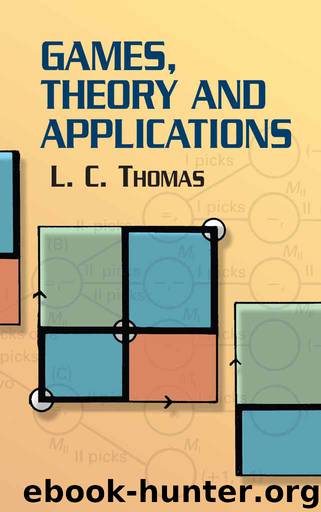Games, Theory and Applications by L. C. Thomas

Author:L. C. Thomas
Language: eng
Format: epub, azw3
Publisher: Dover Publications, Inc.
Published: 1984-06-26T16:00:00+00:00
On adding k1 to the title of the game, what happens to the sets? If k1 has appeared before in the title, then because of Theorem 6.2 will remain metarational. If not and k1 = {i}, then because of the definition of Fi there will be no change since k2,k3,...,kr remain in Fi Thus, (6.35) is the condition for to be metarational for k1k2...krG as well as k2...krG. Lastly, if k1 was in Ui originally it now enters Pi, and since
if satisfies (6.35), it also satisfies the equivalent condition for it to be metarational for i in k1k2...krG.
This result implies that we need only look at the games 123... nG, or nn — 1...21G and all such permutations of l,2,...,n, to find the metaequilibria. These games, where the title is some permutation of 1,2,...,n, are called complete games.
Definition 6.4. An outcome is a symmetric metaequilibrium if it is a metaequilibrium in all complete games.
If G has two players the symmetric metaequilibria are Ê(12G) ∩ Ê(21G), and for the Prisoners’ Dilemma, the Falklands War, and the Cuban missile crisis all the metaequilibria are symmetric. This need not always be the case—look at the following example.
Download
Games, Theory and Applications by L. C. Thomas.azw3
This site does not store any files on its server. We only index and link to content provided by other sites. Please contact the content providers to delete copyright contents if any and email us, we'll remove relevant links or contents immediately.
| Biomathematics | Differential Equations |
| Game Theory | Graph Theory |
| Linear Programming | Probability & Statistics |
| Statistics | Stochastic Modeling |
| Vector Analysis |
Modelling of Convective Heat and Mass Transfer in Rotating Flows by Igor V. Shevchuk(6406)
Weapons of Math Destruction by Cathy O'Neil(6214)
Factfulness: Ten Reasons We're Wrong About the World – and Why Things Are Better Than You Think by Hans Rosling(4713)
A Mind For Numbers: How to Excel at Math and Science (Even If You Flunked Algebra) by Barbara Oakley(3256)
Descartes' Error by Antonio Damasio(3247)
Factfulness_Ten Reasons We're Wrong About the World_and Why Things Are Better Than You Think by Hans Rosling(3216)
TCP IP by Todd Lammle(3154)
Fooled by Randomness: The Hidden Role of Chance in Life and in the Markets by Nassim Nicholas Taleb(3080)
Applied Predictive Modeling by Max Kuhn & Kjell Johnson(3041)
The Tyranny of Metrics by Jerry Z. Muller(3028)
The Book of Numbers by Peter Bentley(2928)
The Great Unknown by Marcus du Sautoy(2662)
Once Upon an Algorithm by Martin Erwig(2621)
Easy Algebra Step-by-Step by Sandra Luna McCune(2603)
Lady Luck by Kristen Ashley(2553)
Police Exams Prep 2018-2019 by Kaplan Test Prep(2516)
Practical Guide To Principal Component Methods in R (Multivariate Analysis Book 2) by Alboukadel Kassambara(2512)
All Things Reconsidered by Bill Thompson III(2370)
Linear Time-Invariant Systems, Behaviors and Modules by Ulrich Oberst & Martin Scheicher & Ingrid Scheicher(2346)
